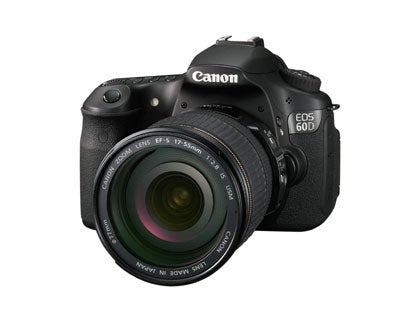UPDATED 8th November, 2012. Released at the end of 2010 the Canon EOS 60D succeeded the EOS 50D that came out in 2008. Despite being over two years old, the Canon EOS 60D is still listed as a current model within Canon’s DSLR range. But can it cut it against the newer competition. The What Digital Camera review finds out...
Canon EOS 60D Review
Features
The sensor in the Canon EOS 60D is the same 18MP model that features in the mid-range 550D, though with the low-pass filter from the 7D, for better colour reproduction. This is  an APS-C sized CMOS sensor outputting at 5184 x 3456 pixels, or roughly A3 at 300dpi.
an APS-C sized CMOS sensor outputting at 5184 x 3456 pixels, or roughly A3 at 300dpi.
The processor is the same DIGIC 4 as the previous 50D but only a single unit, rather than the dual processors of the 7D. This provides burst shooting at a conservative 5.3fps compared to the 6.3fps of the 50D, due to the larger file sizes created by the higher-resolution sensor. The ISO offers a 100-6400 range in standard mode, with an extended ISO 12,800 available for extreme low-light work.
This is the same range as the 50D, though the ISO 6400 setting was previously an extended setting, suggesting that its quality has been improved upon. There is also an Auto ISO setting with a selectable maximum from 400-6400 in the menu. The integrated cleaning system also remains, that shakes dust and dirt from the sensor.
The metering system is Canon’s latest iFCL (intelligent Focus Colour Luminance) 63 zone affair, as featured in the 7D, and offers four options: Evaluative, Partial, Centre-weighted, and Spot. It also features a nice wide exposure compensation range of +/-5 EV.
Auto focus surprisingly remains unchanged from the 50D, with just nine all-cross type AF points, with an f/2.8 sensitivity on the centre point. This has proved to be a successful set-up but does seem sparse against its competition.
White Balance can be selected in Auto (AWB) mode, a series of six presets, a colour temperature selection and one custom mode. Further white balance compensation is available in all settings. The shooting modes cover the usual manual and priority modes (PASM), with the addition of a Bulb and Custom mode, allowing you to save your favourite settings.
There are also a set of five iconised Scene modes, alongside Canon’s Creative Auto mode, for a more graphical camera control, no-flash mode, and full Auto in the form of the ‘Green Square’. One of the more landmark additions to the 60D is the inclusion of advanced creative modes.
These are post-processing options that allow you to add creative effects such as grainy Black and White, miniature, toy Camera, and soft Focus to an image and save it as a separate file. Each mode offers a degree of control to tailor the effect to the image.
There are also in-camera options to resize images and even process Raw files into JPEGs, with a range of adjustments available before processing. The optical viewfinder offers a 96% coverage with a 0.95x magnification, for a reasonably large display, though not to the same extent as the 7D.
 The LCD screen is 3in in size with a huge 1024k-dot resolution. If that’s not enough the 60D is the first EOS model to have its screen on a vari-angle mount, giving 180° horizontal and 270° vertical adjustment, allowing it to be viewed from almost any angle. Live view features a choice of three AF modes (Live, Quick and Face Detection) as well as a choice of grids and aspect ratios.
The LCD screen is 3in in size with a huge 1024k-dot resolution. If that’s not enough the 60D is the first EOS model to have its screen on a vari-angle mount, giving 180° horizontal and 270° vertical adjustment, allowing it to be viewed from almost any angle. Live view features a choice of three AF modes (Live, Quick and Face Detection) as well as a choice of grids and aspect ratios.
The one feature that was in little doubt as to its addition was HD video, and like the 7D and 550D it features Full HD 1080p capture at 30/25/24fps. Video exposure can be controlled in both Auto and full Manual exposure, with autofocus available via the AF-on button.
The inbuilt flash unit offers a fairly standard guide number of 13 and 17mm coverage but adds wireless flash control for up to two groups of Speedlite flashguns, making it only the second Canon EOS to do so.






